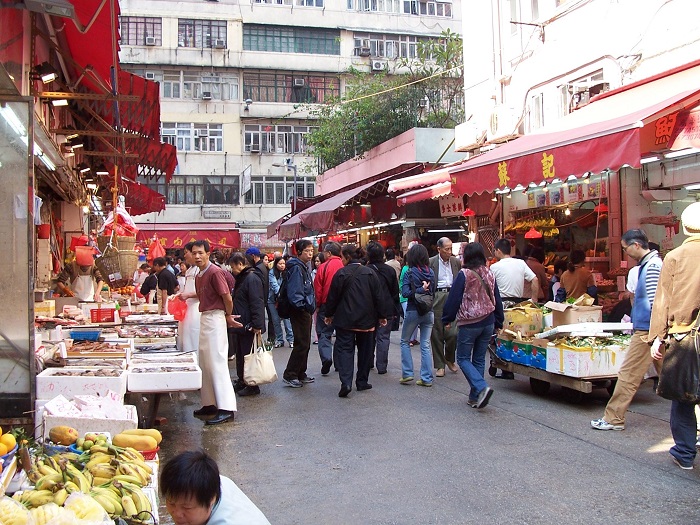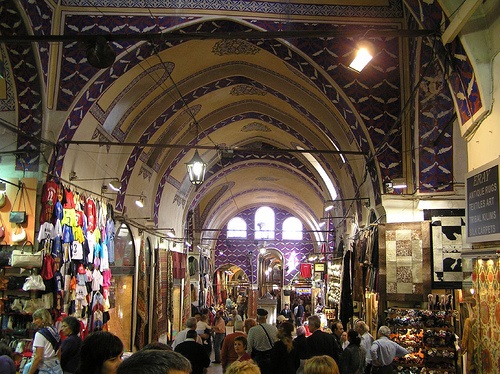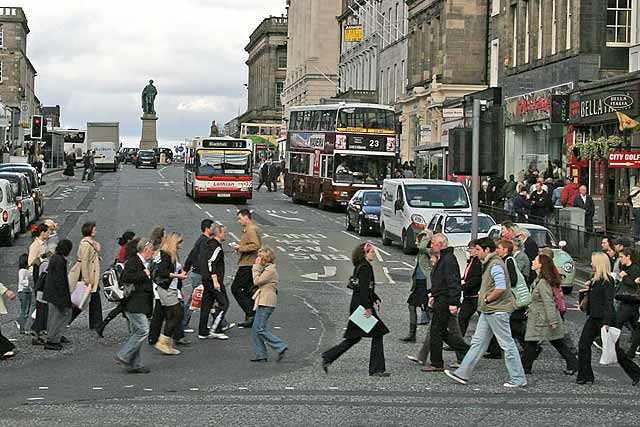As a break from my urbanist rants, I've spent the last several weeks planning and working on a video game for the 7dfps challenge. You can find out more information about my video game, Drenched, on the 7dfps website.
Public markets, when done right, are a vital part of a healthy urban economy. They encourage innovation, they create activity, and most of all, they lower the cost of entry to the market, which in turn, encourages jobs to locally grow. By now, I hope that you understand that economy gardening - 'growing' jobs rather than 'importing' jobs - is a vital part of a healthy economy, to avoid becoming a Copy-and-Paste town. Public markets are just one way you can encourage economic gardening, and as an added benefit, they contribute to the environment to create interesting urban destinations;
For economic gardening to work, we need to lower (or eliminate) the cost of starting a new business venture. The cost of entry in many towns today is extremely high, compared to what it could be. I am going to compare two extreme examples.
If you live in a town overrun with big box stores, the average Joe may come up with an idea for a wonderful product, but he feels kind of hopeless if he wishes to make an impact in his local economy. If he wants to bring his product to the market, or open up his own store, how is he suppose to compete with the multi-billion dollar chain corporations in the town?
Not only could they wipe his specialty business out with a single sales discount, but where is the motivation for starting the business in the first place, when the cost of opening a store is in the hundreds-of-thousands/millions of dollars - megastructures surrounded by parking and drive throughs - if that is all that can survive in your town?
The suburban environment is a very expensive environment to build in and maintain, and places small businesses at a disadvantage - often this benefits big box stores and franchises - because it keeps the cost of entry extremely high for local players that want to get started.
Let's go to the extreme opposite...
Public/street markets:
I love them - and their indoor varieties;
Why do I love them? Because of their ultra low cost of entry. If the average Joe has an idea, he does not need investors - just an idea, a table, and a small space rental fee.
You could be a 13 year old kid that thinks you have invented the next hit street food - deep fried eggs dipped in chocolate - all you have to is bring a table from home, pay your $20 fee for the day, and see how well it sells. If it does not take off, come back next week selling grandpa's bird houses. If one of their ideas really takes off, when they graduate school they could open a more permanent store front.
That is the sort of innovation and motivation we need if we are going to rebuild our economy from the ground up - lower the cost of entry to the point where it just takes an idea and a little bit of motivation.
The cost of entry needs to be as low as possible ($20/day to ideally free) and as least restrictive as possible (allowing farmers to sell their produce, spring cleaners to sell their antiques, or a hobbyist potter to try to see if they can make some extra pocket money selling ceramic tooth brush holders) to enable anyone with an idea and some free time to experiment.
There is also the wrong way to go about a public market. If it costs $500 per day to rent a space, and requires extensive customization and branding, then essentially you are creating an arcade, complete with its high cost of entry;
Or, the more modern mall;
It is not that I dislike arcades or malls, but there is a distinction between a public market - where you can rent a stall for a day or two, and an arcade - occupied by long term tenants that have customized their shop fronts.
It's Not NewPublic markets are nothing new. Most cities throughout history were established along vital trade routes, and flourished due to trade and commerce. Merchants would come in from around the region (and some from around the world), farmers would come to sell their produce, general citizens and store owners would come out for the day, and public markets were an ingrained part of economic life;
More established cities decided to invest a lot of money into building grand market halls where this commerce could take place;
In the Arab world, these were known as bazaars;
Public markets played an important role throughout history, and were the foundation of modern commerce and trade. Yet, our rapid suburbanization has killed them (or at least severely decreased their importance) in many of today's automobile-dependent cities. What we have lost is not just a great urban destination that generated foot traffic, but also an important incubator of economic and urban activity.
The Purpose of StreetsFor most of history, the street was viewed as simply a paved surface between buildings that could be used for any form of activity - children could play, you could eat and socialize, or you could pull up your wagon full of wares for any potential buyer that may stroll past;
The fact that you could use streets to walk between buildings was just one use for them. Streets were viewed as the public realm - a place where activity occured. It was a very unregulated place;
By the mid-19th century, the perception of the street seemed to change. On wide hypertrophic streets, people naturally stood to the side to give way to horses and carts, and often only the sidewalks were smoothly paved to save money, but in many places, the street was still a mixed-use social place;
In some parts of the world, this is still true;
Yet today, the common perception of a street is that its sole purpose is to act as an over-regulated tool purely to be used for transportation;
Even in pedestrian heavy areas;
They are still often seen as tools for getting from A to B. They are designed to get people between destinations as fast as possible, rather than be the destinations themselves - as a place designed for people to occupy. It is rare to see children playing in the streets, usually at least 4/5 of the sidewalk is dedicated to the automobile, and you cannot just pull up your (metaphorical) wagon and start selling goods, or put on a public show.
Should our streets be unregulated public spaces like they once where, or should they be purely tools for transportation?
Encouraging Street ActivityThere is plenty of potential for us to reclaim these streets for public life, as they were once used for. When I was walking around the streets of Saint Louis during lunch time, it felt eerie and abandoned. There was barely a car or a soul on the street, yet they had all of this beautiful public space:
In many American cities like Saint Louis, you could do without that extra traffic lane on every single street. On many of these streets, you could pull the sidewalk out into this extra lane;
In the lower diagram, I have widened the sidewalks, and what were the outer lanes are now the 'permit area.' People can request a permit to utilize part of this area. Ideally, the permits will be extremely cheap, or even free, avaliable in any time length (half a day, to indefinitely reserving a spot on the condition that they are actively utilizing it.) With a permit, they are allowed to do anything they want in their permit zone - play a guitar, set up a coffee stall, pose as a live statue, perform a juggling act, or sell custom printed t-shirts;
In a city like Saint Louis, with plenty of extremely wide streets, we could make this 'market street' the de facto street template for all but the occasional aterial street that actually needs four lanes.
I see multiple advantages of doing this;
- By putting it in its own 'lane' we can accommodate for street vendors with minimal interference to pedestrian and vehicle traffic.
- It is cheaper - you do not have to construct and maintain a dedicated market building. You are re-purposing the infrastructure (the sidewalk and paved street) that already exists.
- It makes the streets more vibrant because the vendors are not hidden inside of a building somewhere.
- It is a cheap and easy way to rejuvenate pedestrian-unfriendly blank-wall streets that are otherwise boring and uninteresting.
- You are not forcefully creating a street market, just enabling the conditions for it. By making it the de facto street template, you are not telling them where they can set up shop, instead they will pop up organically in the areas where there will be the most demand for it.
- By not restricting where in the city they can set up, or what they can utilize their permit for, you open up the potential of creating an interesting variety of uses. Like-vendors may be interested in grouping together - food carts could group together to create a 'food strip' that is popular at lunch, or a 'souvenir strip' could emerge in front of your city's main tourist attractions.
- By not isolating vendors inside of an indoor market, you are encouraging impromtu exposure (imagine your eyes notice those interesting gadgets being sold as you walk past them on your way into the office) for people that may not go out of their way to an indoor market.
I view such street activity as an extension of a public market. A public market, be it indoors or outdoors;
Is great for economic gardening - public markets lower the cost of entry, they allow anybody to experiment with capitalism on the front line, and they act as an incubator of innovation and jobs. We can push this concept to the very edge, and try to reclaim our streets away from being purely tools for transportation back to being general purpose open space for the public realm. By embracing street activity, imagine how we could rebuild our city's economy and culture from the ground up;
I love public markets, from both an urban perspective - they are interesting places that generate a lot of foot traffic, and from an economic perspective - they act as powerful incubators of economic activity - and that goes a long way towards our goal of growing jobs locally to creating strong local economies.
That does not mean we have to stop there, we can extend the idea out on to the streets and reclaim them for general purpose activity, so that we may keep creating pleasant, human-scale urban environments full of interesting activity;








































